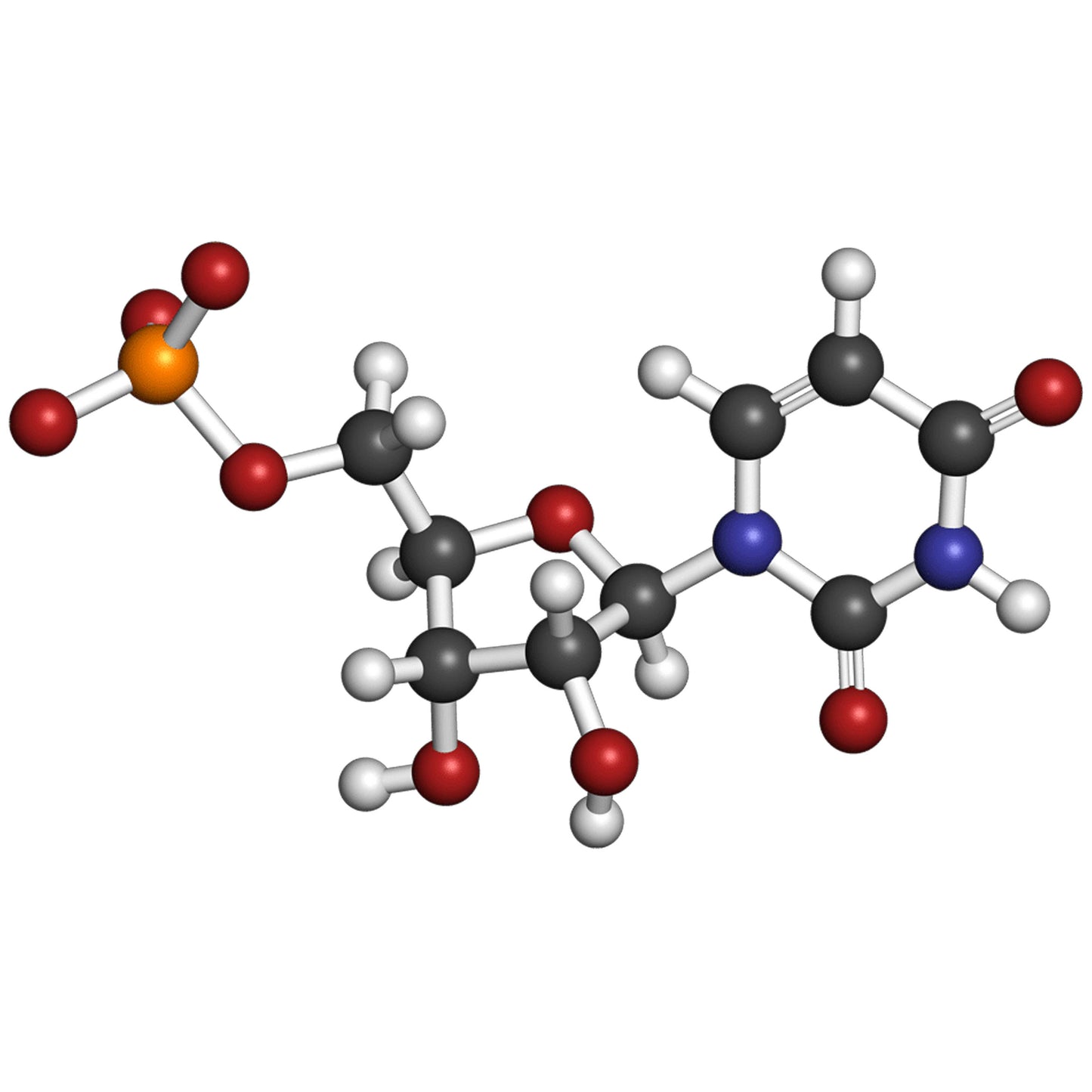
Overview
Uridine is a powerful cognitive enhancer, a potent neuroprotectant, and a fundamental biological component so important that life can’t exist without it.

Uridine Common Name
Uridine, Uridine monophosphate, Uridine-5′-monophosphoric acid, UMP, 5′-Uridylic acid.
Top Benefits
Supports cognitive function
Supports sleep
What is Uridine?
Uridine is one of the 5 standard nucleosides; the others are adenosine, cytidine, guanosine, and thymidine. These compounds are the building blocks of the main information carrier molecules in the body (DNA and RNA), and play a central role in cellular metabolism. ATP – the “A” standing for adenosine – is known for its role in carrying packets of chemical energy needed for cellular functions. Uridine plays a similar role in two non-ATP high-energy molecules used in a subset of metabolic reactions. Uridine is needed for UTP (made from uridine instead of adenosine) as an activator of substrates in some specific metabolic reactions. Uridine can also be converted into cytidine and support CTP. In this role, it is used for the synthesis of the glycerophospholipids (including phosphatidylcholine in the Kennedy pathway) needed for healthy cell membranes throughout the body and in the brain. And uridine may support different neuroregulatory processes and neurotransmitters. Uridine also crosses the blood brain barrier [1–6]. These structural and functional roles have led to it being used as a nootropic. Uridine is considered to be one of the natural sleep-promoting substances made by the brain, acting via uridine receptors in the areas of the brain which regulate natural sleep [7, 8].
Marco’s Grounds Uridine Sourcing
Uridine is supplied in a phosphorylated form as Uridine-5′-monophosphoric acid because this form is more stable, helps it get past the digestive system and liver intact, and allows it to cross the blood-brain barrier.
Uridine is Non-GMO and Vegan.
Uridine Dosing Principles and Rationale
One of our dosing principles is to determine whether there is a dosing range, in which many of the benefits occur and above which there appears to be diminishing returns, i.e., a threshold, and to provide a dose within this threshold range (see Marco’s Grounds Dosing Philosophy). We consider uridine to be one of these threshold compounds. Uridine is most commonly used for cognition support. In this functional role, it is common to take a dose of between 150-250 mg. For cognition enhancing purposes, we dose uridine in this range.
Uridine Key Mechanisms
Brain function
Supports memory [9]
Supports brain membrane glycerophospholipids [10–12]
Supports the Kennedy (or CDP-choline) pathway, which has a central role in choline homeostasis [2, 13, 14]
Supports phosphatidylcholine synthesis [2, 13, 14]
Supports acetylcholine synthesis [2, 10, 13, 14]
Supports cytidine levels and brain CDP-choline [1, 15]
Supports activity of GABA receptors [16, 17]
Supports GABAergic neurotransmission [18, 19]
Supports dopamine release [20]
Acts as a neurotransmitter via purinergic receptors [21, 22]
Supports neurite outgrowth [20, 23]
Sleep
Considered an endogenous sleep-promoting substance [7, 8, 24]
Supports slow wave sleep (SWS) and REM sleep [24–28]
Other effects
Supports cardioprotective functions [29]
Synergies
With DHA in supporting memory and in upregulating dendritic spine density, synaptic protein levels, and phospholipids in the brain [11, 30–33]
Uridine Deep Dive
References
- Cansev, M., Watkins, C. J., van der Beek, E. M., & Wurtman, R. J. (2005). Oral uridine-5′-monophosphate (UMP) increases brain CDP-choline levels. Brain research, 1058(1-2), 101-108.
- Gibellini, F., & Smith, T. K. (2010). The Kennedy pathway—de novo synthesis of phosphatidylethanolamine and phosphatidylcholine. IUBMB life, 62(6), 414-428.
- Weiss, G. B. (1995). Metabolism and actions of cdpcholine as an endogenous compound and administered exogenously as citicoline. Life sciences, 56(9), 637-660.
- Richardson, U. I., Watkins, C. J., Pierre, C., Ulus, I. H., & Wurtman, R. J. (2003). Stimulation of CDP-choline synthesis by uridine or cytidine. Brain research, 971(2), 161-167.
- Ulus, I. H., Mauron, C., & Krzysztof, J. (1989). Choline increases acetylcholine release and protects against the. Brain research, 484, 217-227.
- Cornford, E. M., & Oldendorf, W. H. (1975). Independent blood-brain barrier transport systems for nucleic acid precursors. Biochimica et Biophysica Acta (BBA)-Biomembranes, 394(2), 211-219.
- Komoda, Y., Ishikawa, M., Nagasaki, H., Iriki, M., Honda, K., Inoue, S., … & Uchizono, K. (1983). Uridine, a sleep-promoting substance from brainstems of sleep-deprived rats. BIOMEDICAL RESEARCH-TOKYO, 4, 223-227.
- Kimura, T., Ho, I. K., & Yamamoto, I. (2001). Uridine receptor: discovery and its involvement in sleep mechanism. Sleep, 24(3), 251-260.
- Teather, L. A., & Wurtman, R. J. (2006). Chronic administration of UMP ameliorates the impairment of hippocampal-dependent memory in impoverished rats. The Journal of nutrition, 136(11), 2834-2837.
- Wang, L., Albrecht, M. A., & Wurtman, R. J. (2007). Dietary supplementation with uridine-5′-monophosphate (UMP), a membrane phosphatide precursor, increases acetylcholine level and release in striatum of aged rat. Brain research, 1133, 42-48.
- Wurtman, R. J., Ulus, I. H., Cansev, M., Watkins, C. J., Wang, L., & Marzloff, G. (2006). Synaptic proteins and phospholipids are increased in gerbil brain by administering uridine plus docosahexaenoic acid orally. Brain research, 1088(1), 83-92.
- Agarwal, N., Sung, Y. H., Jensen, J. E., daCunha, G., Harper, D., Olson, D., & Renshaw, P. F. (2010). Short‐term administration of uridine increases brain membrane phospholipid precursors in healthy adults: a 31‐phosphorus magnetic resonance spectroscopy study at 4T. Bipolar disorders, 12(8), 825-833.
- Li, Z., & Vance, D. E. (2008). Thematic review series: glycerolipids. Phosphatidylcholine and choline homeostasis. Journal of lipid research, 49(6), 1187-1194.
- Fagone, P., & Jackowski, S. (2013). Phosphatidylcholine and the CDP–choline cycle. Biochimica et Biophysica Acta (BBA)-Molecular and Cell Biology of Lipids, 1831(3), 523-532.
- Ulus, I. H., Watkins, C. J., Cansev, M., & Wurtman, R. J. (2006). Cytidine and uridine increase striatal CDP-choline levels without decreasing acetylcholine synthesis or release. Cellular and molecular neurobiology, 26(4-6), 561-575.
- Guarneri, P., Guarneri, R., Mocciaro, C., & Piccoli, F. (1983). Interaction of uridine with GABA binding sites in cerebellar membranes. Neurochemical research, 8(12), 1537-1545.
- Guarneri, P., Guarneri, R., Bella, V. L., & Piccoli, F. (1985). Interaction Between Uridine and GABA‐Mediated Inhibitory Transmission: Studies In Vivo and In Vitro. Epilepsia, 26(6), 666-671.
- Liu, P., Wu, C., Song, W., Yu, L., Yang, X., Xiang, R., … & Yang, J. (2014). Uridine decreases morphine-induced behavioral sensitization by decreasing dorsal striatal dopamine release possibly via agonistic effects at GABAA receptors. European Neuropsychopharmacology, 24(9), 1557-1566.
- Liu, P., Che, X., Yu, L., Yang, X., An, N., Song, W., … & Yang, J. (2017). Uridine attenuates morphine-induced conditioned place preference and regulates glutamate/GABA levels in mPFC of mice. Pharmacology Biochemistry and Behavior, 163, 74-82.
- Wang, Lei, Amy M. Pooler, Meredith A. Albrecht, and Richard J. Wurtman. “Dietary uridine-5′-monophosphate supplementation increases potassium-evoked dopamine release and promotes neurite outgrowth.” Journal of molecular neuroscience 27, no. 1 (2005): 137-145.
- Brunschweiger, A., & Muller, C. E. (2006). P2 receptors activated by uracil nucleotides-an update. Current medicinal chemistry, 13(3), 289-312.
- Dobolyi, A., Juhász, G., Kovács, Z., & Kardos, J. (2011). Uridine function in the central nervous system. Current topics in medicinal chemistry, 11(8), 1058-1067.
- Pooler, A. M., Guez, D. H., Benedictus, R., & Wurtman, R. J. (2005). Uridine enhances neurite outgrowth in nerve growth factor-differentiated pheochromocytoma cells. Neuroscience, 134(1), 207-214.
- Honda, K., Komoda, Y., Nishida, S., Nagasaki, H., Higashi, A., Uchizono, K., & Inoué, S. (1984). Uridine as an active component of sleep-promoting substance: its effects on nocturnal sleep. Neuroscience research, 1(4), 243-252.
- Kimura-Takeuchi, M., & Inoué, S. (1993). Differential sleep modulation by sequentially administered muramyl dipeptide and uridine. Brain research bulletin, 31(1-2), 33-37.
- Inoue, S., Kimura-Takeuchi, M., & Honda, K. (1990). Co-circulating sleep substances interactingly modulate sleep and wakefulness. Endocrinologia experimentalis, 24(1-2), 69-76.
- Inoue, S., Honda, K., Komoda, Y., Uchizono, K., Ueno, R., & Hayaishi, O. (1984). Differential sleep-promoting effects of five sleep substances nocturnally infused. Proceedings of the National Academy of Sciences, 81(19), 6240-6244.
- Kimura-Takeuchi, M., & Inoué, S. (1993). Lateral preoptic lesions void slow-wave sleep enhanced by uridine but not by muramyl dipeptide. Neuroscience letters, 157(1), 17-20.
- Krylova, I. B., Bulion, V. V., Selina, E. N., Mironova, G. D., & Sapronov, N. S. (2012). Effect of uridine on energy metabolism, LPO, and antioxidant system in the myocardium under conditions of acute coronary insufficiency. Bulletin of experimental biology and medicine, 153(5), 644-646.
- Holguin, S., Huang, Y., Liu, J., & Wurtman, R. (2008). Chronic administration of DHA and UMP improves the impaired memory of environmentally impoverished rats. Behavioural brain research, 191(1), 11-16.
- Holguin, S., Martinez, J., Chow, C., & Wurtman, R. (2008). Dietary uridine enhances the improvement in learning and memory produced by administering DHA to gerbils. The FASEB Journal, 22(11), 3938-3946.
- Sakamoto, T., Cansev, M., & Wurtman, R. J. (2007). Oral supplementation with docosahexaenoic acid and uridine-5′-monophosphate increases dendritic spine density in adult gerbil hippocampus. Brain research, 1182, 50-59.
- Cansev, M., & Wurtman, R. J. (2007). Chronic administration of docosahexaenoic acid or eicosapentaenoic acid, but not arachidonic acid, alone or in combination with uridine, increases brain phosphatide and synaptic protein levels. Neuroscience, 148(2), 421-431.
